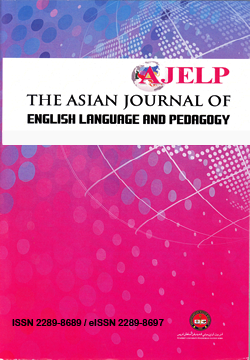The Use of Gesticulation to Improve Esl Learner’s Understanding of Content Words in Writing
DOI:
https://doi.org/10.37134/ajelp.vol10.2.3.2022Keywords:
content words, gesticulation, narrative writingAbstract
The present study aims to evaluate the effects of gesticulation on English as Second Language (ESL) learners’ understanding of content words in narrative writing. A mixed-method approach involving quantitative and qualitative data collection method was utilized in this study. Pre-test and post-test were used to collect quantitative data and interviews were used to collect qualitative data. This study was conducted among 40 Year Five students who struggled to write a narrative essay with suitable content words. They were chosen using convenience sampling and divided into twenty students in experimental and control groups respectively. Content words for three themes of narrative writing were taught using gesticulation for the experimental group, while the control group was taught content words using the traditional method of teaching. The pre-test and post-test data were analysed using an independent T-test whereas the interview data were analysed thematically. The findings showed that there are significant differences in the level of the learner’s understanding of content words in narrative writing based on pre-test and post-test results of the experimental group. The learners’ performance in narrative writing showed improvement in the post-test of experimental group. Moreover, the findings from the interview revealed that the learners have positive perceptions in using gesticulation to understand content words that helped them in narrative writing. The study implicates that the use of gesticulation can enhance the learners’ understanding of content words that improve their narrative writing.
Downloads
References
Afaf Abdelrahim, J. E. A. (2017). The role of vocabulary learning strategies in enhancing writing skills. International Journal of Humanities Social Sciences and Education, 4(8), 41-50.
Anson, J. P. (2017). Writing attitudes and practices of content area teachers after participating in the central Utah writing project summer institute (Doctoral dissertation, Utah State University, Utah). Retrieved from https://digitalcommons.usu.edu/etd/6363
Caselli, M.C., Stefanini, S. & Volterra, V. (2012). Early action and gesture ‘vocabulary’ and its relation with word comprehension and production. Child Development, 83(2). 526-542.
Clark, J. & Trofomovich, P. (2016). L2 vocabulary teaching with student- and teacher-generated gestures: A classroom perspective. TESL Canadian Journal, 34(11), 1-24.
Gilford, L. R. (2016). The beliefs, perceptions and strategies of vocabulary instruction in middle grades social studies: A phenomenological study. Educational Research, 3(2), 156-189.
Gunday, R. & Atmaca, H. (2016). Vocabulary teaching in action-oriented approach. Participatory Educational Research, 1(4), 112-121.
Heidari, K. (2015). An investigation into the role of gesture in enhancing children’s vocabulary command. International Journal of Early Years Education, 23(4), 382-393.
Hoque, M. E. (2017). Context-based strategies for teaching vocabulary at the secondary level in Bangladesh. Journal of Learning and Teaching, 3(4), 11-24.
Huang, X., Kim, N. & Christianson, K. (2019). Gesture and vocabulary learning in a second language. Language Learning, 69(1), 1777-197.
Kalinauskaitė, D. (2017). Detecting information-dense tests: Towards an automated analysis. Journal of Applied Linguistics, 1(5), 95-99.
Khanukaeva, A. (2014). The effects of iconic gestures on L2 vocabulary learning in a Norwegian primary school. Unpublished Master’s Thesis, Faculty of Arts and Education, University of Stavanger.
McNeill, D. (1985). So you think gestures are nonverbal?. Psychological Review, 92(3), 350-371.
McNeill, D. (1992). Hand and Mind: What Gestures Reveal About Thought. Retrieved from https://mcneilllab.uchicago.edu/pdfs/gesture.thought.fundamentals.pdf
Melor Md Yunus. & Chan, H. C. (2016) The use of mind mapping strategy in Malaysian University English Test (MUET) writing. Creative Education, 7(4), 619-626.
Muller, C. (2018). Gesture and sign: Cataclysmic break or dynamic relations? Journal of Psychology, 8(1651), 1-20.
Nur Fatima Wahida Mohd Nasir., Nor Ashikin Ab Manan. & Noraziah Azizan. (2017). Examining the relationship between vocabulary knowledge and general English language proficiency. Journal of Social Sciences and Humanities, 1(3), 15-22.
O’Callaghan, J. (2014). How A Child's Language Development Can Be Helped By Hand Movements: Gesticulating Makes Words 'Easier To Understand. Retrieved from https://www.dailymail.co.uk/sciencetech/article-2729665/How-childs-language development-helped-hand-movements-Gesticulating-makes-words-easier-understand.html
Shahabi, H. & Shahrokhi, M. (2016). Contributing role of the gestures and facial expressions in teaching concrete vocabulary items to Iranian elementary ELF learners. Journal of Applied Linguistics and Language Research, 3(5), 160-176.
Smith, I. H. & Larry, M. K. (2015). Gesticulation and effective communication. International Journal of Linguistics and Communication, 3(2), 1-5.
Solati-Dehkordi, S. A. & Salehi, H. (2016). Impact of explicit vocabulary instruction on writing achievement of upper-intermediate EFL leaners. International Education Studies, 9(4), 142-254.
Uma Maheswari, V. & Shahin Sultana, A. (2019). VLS Model for content words: An experimental study on engineering students in India. Journal of Language Studies, 19(1), 62-77.
Van Compernolle, R. A. & Smotrova, T. (2017). Gesture, meaning and thinking for teaching in unplanned vocabulary explanations. Journal of Classroom Discourse, 3(12), 11-32.
Viera, R.T. (2017). Vocabulary knowledge in the production of written texts: A case study on EFL language learners. Journal of EPSOL Technological Magazine, 30(3), 89-105.
Yates, P. H., Cuthrell, K. & Rose, M. (2011). Out of the room and into the hall: Making content word walls work. English Language and Linguistics, 84(1), 31-36.
Downloads
Published
Issue
Section
License
Copyright (c) 2022 Noor Alhusna Madzlan, Rebecca Mary Sartho, Mazlin Mohamed Mokhtar

This work is licensed under a Creative Commons Attribution-NonCommercial-ShareAlike 4.0 International License.





